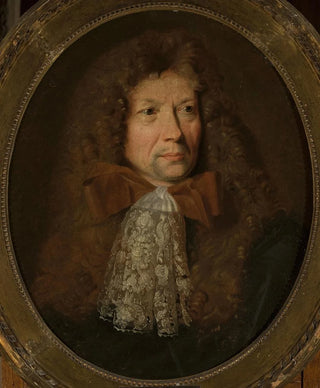Art print | Portrait of a man Pierre van Schuppen - Nicolas de Largillière


View from behind

Frame (optional)
Pierre van Schuppen - Nicolas de Largillière – Captivating Introduction
The "Portrait of a Man" by Nicolas de Largillière, depicting Pierre van Schuppen, is a work that transcends the simple frame of painting to become a significant part of 17th-century French art history. This painting, imbued with sophistication and psychological depth, invites the viewer to delve into the intimate universe of the portraitist and his subject. The light, colors, and texture of the clothing combine to create an atmosphere that is both realistic and poetic, where every detail seems to tell a story. This portrait does not merely capture the physical appearance of its subject; it also reveals a part of his soul, a quest for identity that still resonates today.
Style and uniqueness of the work
Largillière's style is distinguished by its ability to fuse Flemish and French influences, offering a unique approach to portraiture. In this piece, mastery of light and shadow, delicacy of features, and rendering of textures demonstrate exceptional craftsmanship. Pierre van Schuppen's face, rendered with remarkable precision, expresses a certain nobility, while the details of his attire, adorned with rich embroidery, evoke a high social status. The composition is carefully balanced, with each element finding its place within a harmonious whole. This art print is not limited to a simple representation; it becomes a mirror of the aspirations and values of its time, a living testimony of a society in full transformation.
The artist and his influence
Nicolas de Largillière, born in Antwerp in 1656, is one of the most renowned portraitists of his era. Established in Paris, he succeeded in establishing himself thanks to his talent and his ability to capture the essence of his subjects. His work marked a transition in the world of portraiture, moving away from rigid conventions to embrace a more free and expressive approach. Largillière influenced many artists who followed him, contributing to the evolution of portraiture in the 18th century. His keen observation and skill in conveying human emotions made him a role model for future generations. Through the "Portrait of a Man," he offers us a glimpse of his creative genius.

Matte finish

View from behind

Frame (optional)
Pierre van Schuppen - Nicolas de Largillière – Captivating Introduction
The "Portrait of a Man" by Nicolas de Largillière, depicting Pierre van Schuppen, is a work that transcends the simple frame of painting to become a significant part of 17th-century French art history. This painting, imbued with sophistication and psychological depth, invites the viewer to delve into the intimate universe of the portraitist and his subject. The light, colors, and texture of the clothing combine to create an atmosphere that is both realistic and poetic, where every detail seems to tell a story. This portrait does not merely capture the physical appearance of its subject; it also reveals a part of his soul, a quest for identity that still resonates today.
Style and uniqueness of the work
Largillière's style is distinguished by its ability to fuse Flemish and French influences, offering a unique approach to portraiture. In this piece, mastery of light and shadow, delicacy of features, and rendering of textures demonstrate exceptional craftsmanship. Pierre van Schuppen's face, rendered with remarkable precision, expresses a certain nobility, while the details of his attire, adorned with rich embroidery, evoke a high social status. The composition is carefully balanced, with each element finding its place within a harmonious whole. This art print is not limited to a simple representation; it becomes a mirror of the aspirations and values of its time, a living testimony of a society in full transformation.
The artist and his influence
Nicolas de Largillière, born in Antwerp in 1656, is one of the most renowned portraitists of his era. Established in Paris, he succeeded in establishing himself thanks to his talent and his ability to capture the essence of his subjects. His work marked a transition in the world of portraiture, moving away from rigid conventions to embrace a more free and expressive approach. Largillière influenced many artists who followed him, contributing to the evolution of portraiture in the 18th century. His keen observation and skill in conveying human emotions made him a role model for future generations. Through the "Portrait of a Man," he offers us a glimpse of his creative genius.






